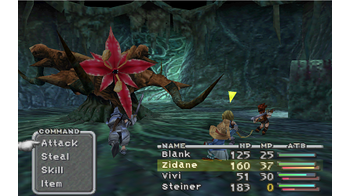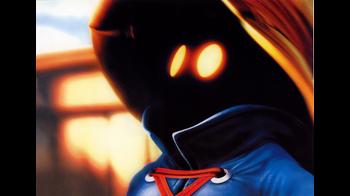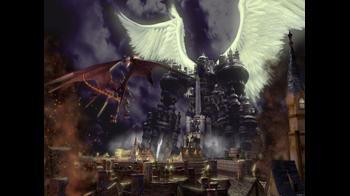
Final Fantasy IX and me - 15 years on
It's weird to put it in writing, but I owe a lot to Final Fantasy IX. It's a deeply special game, and as it turns fifteen years old it'd be wrong to deny the overwhelming sense of nostalgia I feel towards it. I owe so much to it because of a fortuitous, lucky chain of events - but ultimately, it all starts with this game. It led me into the then-thriving fan-run online Final Fantasy community, and that in turn led to websites, writing and studies in journalism. That leads here. RPG Site owes its existence to Final Fantasy IX, and in turn I owe my career to its enormous influence.
Beyond the significance I personally ascribe to it, FF9 is also a special game in the context of the series. In many ways it is a farewell to series creator Hironobu Sakaguchi, who’d step back from the series after this point, and as such it serves as a congratulory hat-tip and back-pat to each game that came before it. Some argue that this makes it less of an original game, or less daring than the FFs that sought to change everything between entries, but I disagree - in the market following the successes of FF7 and FF8 returning to a more traditional title was as much a risk as any other FF has taken.
Packed to the rafters with references small and large to the events, characters and worlds of past games, FF9 is in many ways a turning point, too - everything that comes after it is - sometimes for better, sometimes for worse - quite different. Crucially, FF9 isn't really defined by how it plays tribute to its predecessors either, carving out a brilliant, bright and unmatched identity all of its own.
FF9's success isn't derived from any one source. Sakaguchi was at the height of his career, FF9's development coming before the crushing tumble of a failed attempt to crack Hollywood. Its director Hiroyuki Ito arguably remains Square Enix's most prolifically talented employee, a genius of game design who is largely unmatched in the world of RPG design in Japan. The pair ultimately create a combined vision that's bolstered by truly excellent art and visuals that push the PS1 to its absolute limit - and the result is one of the greatest RPGs ever made.
Toshiyuki Itahana, Hideo Minaba and Shukou Murase team up to provide art that pulls away from the semi-realistic looking visuals offered up by Tetsuya Nomura for the previous two and most subsequent games, coming up with something more exaggerated and full of character.
Being one of the best-looking PlayStation games and one of the better-aging entries in the series visually helps when viewing the game in retrospect, but being pretty alone is a far cry from what makes this game so damn special.The deformed, disproportionate style they settled on is one that isn’t just cute and referential to the sprites of the SNES era - it’s also one that oozes charm, perfectly conveying the whimsical energy and attitude that FF9 carries as its lifeblood.
That charm extends to the cast; lead Zidane is a classic thief with a heart of gold archetype, but surprising depth reveals itself as the game wears on. Every character’s heart rests in such caricatured stereotypes, in fact - but most of the cast eventually break free of their character archetype as the narrative unfolds, with relationships often forming in surprising ways.
Each character unravels brilliantly, and any could serve as an example of FF9's confidently told character beats. Steiner is perhaps one of the best, with his neurotic outbursts charting their way from irritating to funny and finally to endearing as his motivations are laid bare. Meanwhile, the tale of the innocent, sassy Eiko's life alone is strangely unsettling even as FF9 mostly plays it as cute. Even Amarant and the strange Quina, the weakest members of the eight-strong cast, are likeable and interesting, making this a FF ensemble to rival FF6's incredible cast.
ven as a dedicated fan of FF9, I'll happily admit it isn't without fault. Its combat is far too slow and the equipment-based ability system isn't the series' best, but FF9 shines past and through these flaws with ease. Much of weathering these issues is about that previously-mentioned sense of character, with FF9 home to an ensemble cast that can sink its claws into even the most cynical of players though sheer heart and charm.
The real star of the show is Vivi, a Black Mage with a heart of gold and deeply philosophical questions about the meaning of life. FF9 may depict the rise and fall of nations and a jealous plot to destroy all of existence, but Vivi’s story is what the game is really thematically about. All thematic roads lead to him.
Vivi is a fan favorite, beloved by many - and once you begin to understand him, that's no surprise. His plucky attitude in the face of his impending demise not only defines FF9, but underlines a core theme of much of the Sakaguchi-helmed era of the FF series.
The combat is still enjoyable in spite of its sluggish nature - and it is as packed with nods to classic FF as the narrative. Also, before anybody even thinks of suggesting otherwise, Tetra Master is, whatever some say, a valid and fun successor to Triple Triad - it's just a little harder to understand. Bottom line: FF9 is really good bloody fun.
While the narrative is all about character, FF9's actual story still has much to tell. There's a rapid escalation that doesn't feel unnatural - what begins with kidnappings and slapstick romance quickly takes a hard turn into war, death and the wishes of a genocidal maniac.
The manner in which FF9 shifts through these tonal shifts remains impressive among FF9's peers - and many of the shifts are punctuated by some of the best moments in the series. Who can forget Bahamut versus Alexander and Steiner & Beatrix’s last stand during the assault on Alexandria? Odin’s destruction of Cleyra is still the most bad-ass thing FF's take on the Norse god has done.
Uematsu’s medieval-inspired score - the last he contributed to the series alone - is excellent, pitch-perfect for the world - and arguably a contender for his finest work. Uematsu traveled around Europe in preparation for the game, visiting British towns and French castles to get a feel for what tone he should strike.
This is felt in the game and also is matched in the art - with much of it produced in Hawaii, large amounts of FF9's background renders were produced by Westerners, making it a unique and fascinating outlier in the series, something which only adds to its character.
That controversial final boss may seem a strange choice (and a reference the boss makes to Star Wars Episode I certainly dates the game), but it thematically links to Vivi’s all-important story line while giving one more series nod (to FF3’s Finale). Consider this, too: in first manipulating the nations of Gaia to annihilate each other and then in summoning Necron, who begins to destroy all creation, Kuja is actually the second most successful FF villain behind FF6's world-destroying clown Kefka.
There's a lot of death and destruction, but FF9 remains a bright and colorful game all the same - not just visually, but right through to its heart and soul. This balance of whimsy and gravitas is something FF has always struggled to attain, and something that generally few seem to manage in media in general.
It’s purer and more whimsical than anything since the SNES and anything since, and quite possibly is the last time that the main series will ever tread such ground. While the dystopic world of FFV7’s Midgar fascinates me and the horrors of living under Kefka’s regime intrigues me, FF9 depicts a world that, despite being at war, I’d want to live in.
To me this game embodies what the series should be all about: drama, beauty, fantasy, whimsy - and fun.
If somebody asked me what Final Fantasy is all about and why it’s so loved, fifteen years on I would still point to Final Fantasy IX for the answer. That, I suppose, is the greatest recommendation of all.


